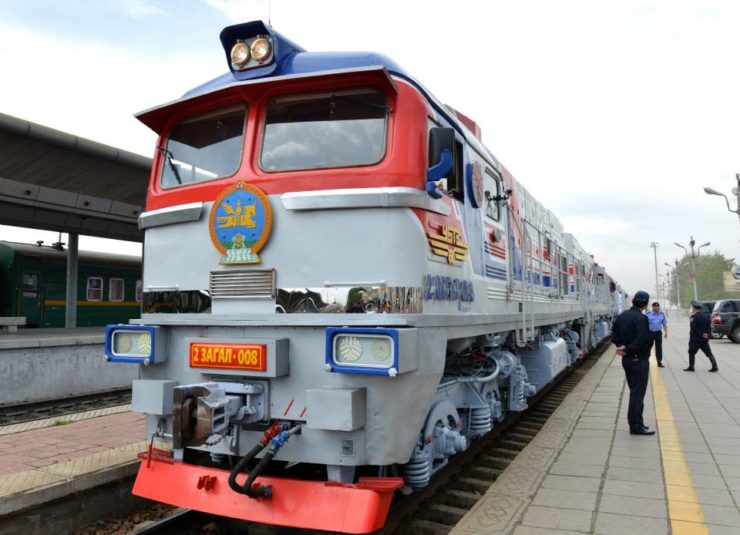
The onset of the first autumn cold weather is a sign that we can begin to summarise the first results of the various undertakings of 2023. This article is a brief overview of the Mongolian government’s preliminary results in the field of railway construction. It is worth noting that Mongolia has made significant progress in this sector this year.
According to the medium-term state development programmes, 1,820 kilometres of railways are planned to be built in the country between 2020 and 2024. Already in 2022 and less than ten months from 2023, Mongolia commissioned three new railways – Tavan Tolgoi-Zuunbayan, Tavan Tolgoi-Gashuunsuhait and Zuunbayan-Hangi – with a total length of almost 900 kilometres.
The main objective of this large-scale construction project is to optimise the supply routes for Mongolian mining products to the Chinese market. The success of recent years in achieving this objective can be characterised by one fact — while in 2022 Mongolia had only one railway crossing point on the border with China (Zamyn—Üüd), in 2024 it will have five – all of which will be directly connected to the country’s largest deposits. This is expected to be the result of extensive work completed, started or planned for this year.
The large activities carried out by the Mongolian authorities in the field of transport infrastructure construction have been favourably noted by the world’s leading experts. Thus, according to the preliminary results of 2023, Mongolia has risen by as much as thirty positions in the so-called “Logistics Performance Index” of the World Bank. Now the country is in the top half of the rating, occupying 97th place (for comparison – Russia is in 88th place, Kazakhstan – 79th).
For a more complete understanding of the situation, it is necessary to refer to the data on specific projects implemented by Mongolia, slightly expanding the chronological framework – in particular, limiting them to 2020-2024 – in the same way as they are specified in the country’s national programmes. As mentioned above, these include the Tavan Tolgoi-Zuunbayan railway, which is 415 kilometres long, the Tavan Tolgoi-Gashuunsuhait railway (233 kilometres) and the Zuunbayan-Khangi railway (227 kilometres), which was commissioned on 25 November 2022, as an extension of the first railway on this list. The road is designed to connect large deposits of coal (including the country’s largest deposit Tavan Tolgoi), iron ore and copper (the promising Oyuu Tolgoi deposit) with the Zamyn-Uud border crossing point on the border with China – through which the railway linking Russia, Mongolia and China has been running for more than 70 years. The Mongolian companies “Mongolian Trans Line” and “Mongolian Trans Logistic” were responsible for the construction of the railway line.
Nevertheless, a significant share of Mongolia’s largest export item, hard coal, continues to be transported by road. Thus, according to the Ministry of Road and Transport Development of Mongolia, in the first eight months of 2023, 84 % of hard coal was transported across the border by dump trucks, and Gashuunsuhait was the main border crossing checkpoint through which these shipments were made (49 % of the volume). However, the railway terminal at Gashuunsuhayt has recently been commissioned, which will allow up to 10 million tonnes of coal to be transported by rail to China as early as 2024.
Two Mongolian haulage companies, namely the state-owned Mongolian Railways and Tavan Tolgoi Railway JSC, are the operators of the 2022-2023 commissioned railways. In the first eight months of 2023, they transported 1.2 million tonnes of freight – this seemingly significant amount is only a small part of the country’s total freight traffic: during the same period in 2023, the country transported almost 48 million tonnes of freight, of which rail transport accounts for at least 7-8 million tonnes. Despite this, the Mongolian authorities plan to increase freight traffic on the new railways to at least 20-25 million tonnes, which, according to their estimates, more than meets the capacity of these highways.
Mongolia also has smaller railway projects, such as the Gashuunsukhayt-Ganzmod, Shivehuren-Sehe and Bichigt-Zuunkhatavch lines, designed to connect new railway lines to border crossings to China in order to optimise Mongolia’s mining exports. Accordingly, these projects are linked to the projects of the so-called “New Crossing Point Rehabilitation Policy”, which envisages the establishment of railway terminals at border crossings. The feasibility study for the Gashuunsukhayt-Ganzmod line project was approved in September this year, and work is scheduled to start in January 2024. Shivehuren-Sehe line (7 kilometres) is scheduled to be commissioned in November this year.
Thus, railway construction in Mongolia in 2020-2024 is characterised by the priority connection of the country’s largest deposits with the railway network of the country’s main importer of mining raw materials, the People’s Republic of China. By the way, in the near future, China may also become a significant transit route for Mongolian minerals: in October 2023, representatives of China, Mongolia and Japan agreed to create a route for Mongolia’s mineral supplies to Japan through the Chinese port of Tianjin. Similar wishes were expressed by representatives of the Republic of Korea during the visit of Mongolian Prime Minister L. Oyun-Erdene to Seoul in early 2023.
However, while Mongolia’s medium-term railway projects are aimed at optimising the country’s exports, the long-term projects focus on a more complex task requiring coordinated cooperation between Russia, Mongolia and China. This task is the realisation of Mongolia’s transit potential along the “China-Russia”, “Russia-China” and “China-Russia-Europe” routes. We will talk about it in the next article on the “transport cycle”.
Boris KUSHKHOV, Department of Korea and Mongolia, Institute of Oriental Studies, Russian Academy of Sciences. Especially for the online magazine “New Eastern Outlook”.
